Presentation, design, and build.
[responsivevoice_button]
With only a buck’s change from $500 the A90 sits above entry-level asking-price, but still well-below ‘high-end’. Still, it’s a not inconsiderable chunk-of-change, and Topping has appropriately delivered a not-inconsiderable looking piece of equipment. After all, it is their ‘flagship’ amplifier, and it certainly gives off premium-vibes in its nice black retail packaging. The A90 ships with a region-appropriate IEC power cord – there’s no wall-wart here thanks to an on-board power-supply (nice). Topping provides a paper manual, warranty card, and a 3.5mm to 6.3mm adapter, and that’s about it. I must have a good thirty-odd 6.3mm adapters, so a 2.5mm to 4.4mm or 2.5mm to XLR one wouldn’t have gone astray, but hey, that’s wishful thinking.
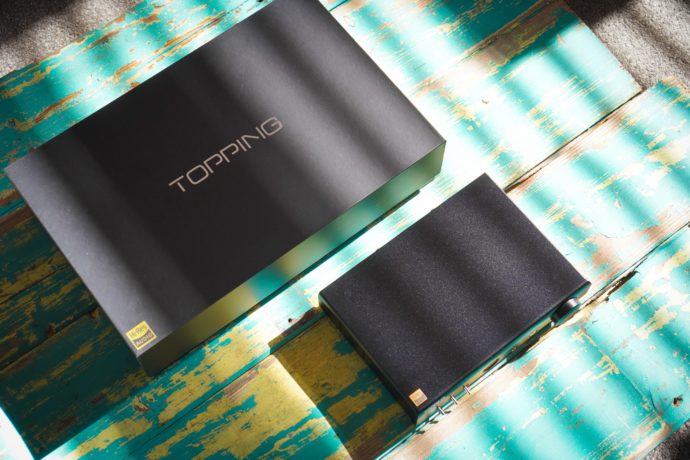
Topping A90 headphone amplifier
I was actually surprised by how compact the A90 is. When you think ‘Flagship’ and ‘Desktop’, you’d be forgiven for thinking this might take up half your table-top, but the A90 is about as large as a medium-sized paperback novel. Or, 22cm x 16cm x 4.5cm to be precise, with a weight of 2.5kg. Equivalently specced and flagship amplifiers from Audio-GD or Schiit Audio, for example, are veritable behemoths by comparison. No, the A90 will happily sit unobtrusively among your other desktop items without robbing too much by way of desktop real estate. It sits on four small rubber feet, and you are often reminded of just how slight it is when plugging/unplugging headphones or swapping cables, as it does tend to slide around a bit. It’s not a major complaint, and it’s better than it weighing a ton, conversely.
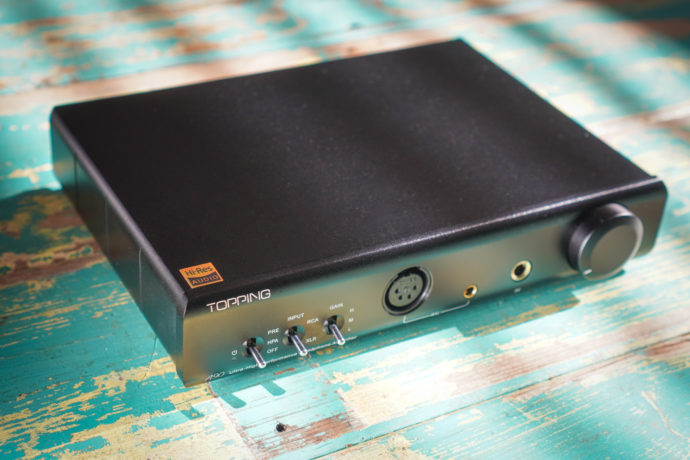
Topping A90 headphone amplifier
The A90’s build is all-metal, with the main body being made from a single piece of semi-matte finished steel, available in either black or silver colourways. The same material is used on the front and rear fascias, and overall the device feels solid and well-made in the hand. The metal toggle switches ‘click’ with a nice, tactile authority, and the connectors are all well-constructed with satisfyingly tight tolerances.
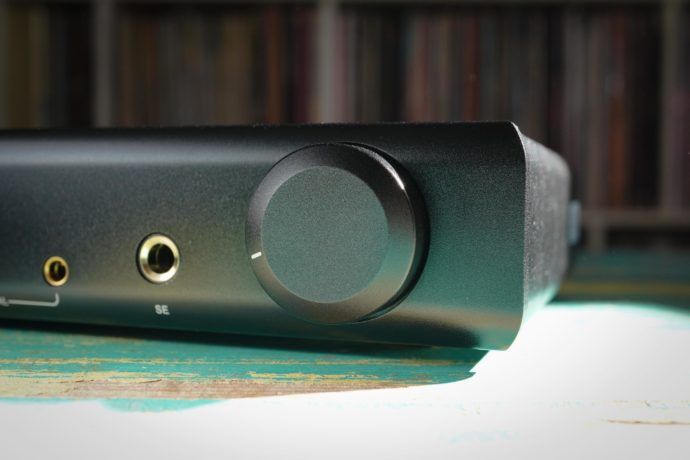
Topping A90’s volume pot
The large, metal volume pot has a smooth, but light throw. While it’s several orders of magnitude better than the awful knob on the SMSL SP200 THX888, I do wish it were as tactile as the superb knob on the Questyle CMA600i, or as easy to locate as the Schiit Audio Asgard 3’s excellent volume pot. The pot on the A90 is a little too flush to its fascia, requiring you to ‘pinch’ it slightly to use. I am nit-picking, however, and it’s certainly not a deal-breaker.
Desktop and system setup.
I spend my review time with the A90 using it as the sole headphone amplifier in my desktop office/listening setup. I fed it with both my turntable and a range of DACs as the upstream sources, and I also used the A90 as a preamp to attenuate volume on my Burson Bang stereo power amplifier, which powers a pair of KEF LS50’s in a nearfield arrangement.
The A90 is a fairly simple analogue instrument and requires very little learning to live with – it’s fairly straightforward and intuitive to use. I did scratch my head once or twice wondering why no sound was coming out when I forgot to select the correct ‘RCA’ or ‘XLR’ line-level input, but that’s about it. It’s more of a headphone amplifier with preamp functionality than vice versa – if it were a more comprehensive preamp than perhaps a remote might have been included with perhaps one more input, but hey – you can’t have everything for $499. The volume pot, aside from my earlier comments, has an easily visible white level indicator which is helpful and also important considering that the A90 can put out a scary amount of power into a pair of headphones, or IEMs for that matter.
If the shape and model name of this amp rings a bell, it might be because you’ve already come across a review of the A90’s digital stablemate, the fully balanced D90. Topping designed the A90 and D90 to work together as high-end counterparts to one another to create the ‘Top’ Topping stack. And what better way to test-out the A90 than with the latest version of the AK44900-equipped D90, the D90 MQA? Since Linus’ review of the D90 Topping has released an updated version of the top-of-the-range digital decoder capable of fully unfolding Meridian’s proprietary MQA format (in addition to DSD 512 and 32-bit/768kHz PCM), along with an updated XMOS XU216 USB chip.
Topping ‘Top-Deck’ stack: the A90 and D90.
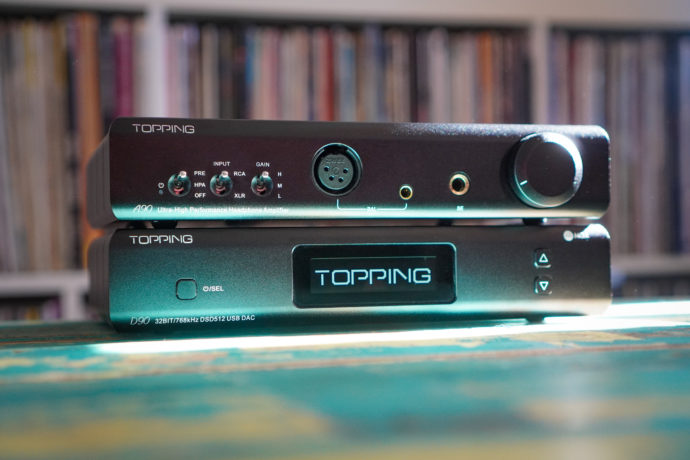
Topping A90 headphone amplifier
The A90/D90 stack makes for a perfectly flush desktop stack, with their cases being exactly the same size and shape. Even with one on top of the other, it still makes for a relatively compact pair that’s considerably more svelte than the corresponding Schiit Audio Asgard 3/Bifrost 2 stack. Using a pair of short XLR interconnects, the two companion Topping devices become a fully balanced team. And from there, simply go-about adding your 2 x power cables (which are thankfully vertically aligned, as are the XLR connections) and digital inputs/analogue outputs of choice. The same comments for the A90’s light-weight apply here, and are multiplied when stacked with the D90 MQA – expect them to shift around a bit, especially whichever one is placed on top. If you’re a sucker for symmetry (like I am), expect to have to realign them from time to time.
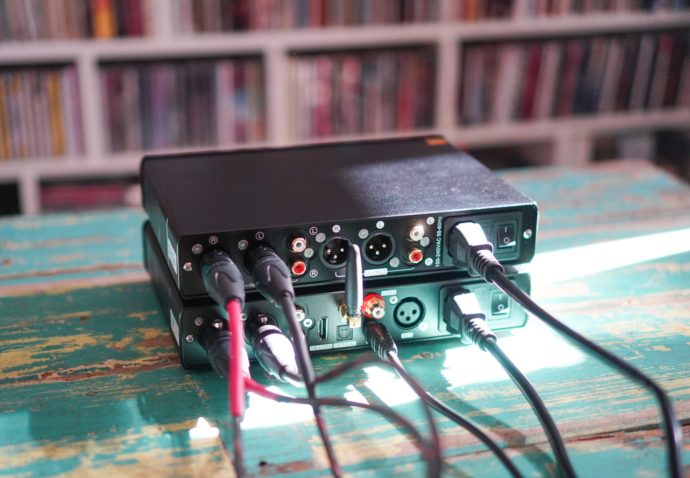
Topping A90 headphone amplifier stacked with D90 MQA DAC
Linus eloquently outlined the abilities and characteristics of the D90 with more time and finesse than I have room for here, but let’s just say that when paired together, the digital brains of the D90 added to the analogue brawn and performance of the A90 all combine to make for a formidable pairing. Would this be better as an all-in-one unit? Probably not, in my opinion. The D90 and A90 are individually brilliant at what they do, and having them designed as separate pieces allows them to focus on what they’re best at, and gives you the flexibility to add them to other items in a pre-existing or future audio chain.
While I’d love to get a little further under the skin of MQA and understand exactly what sets it apart from ‘regular’ PCM, it was nice to be able to browse the ‘Masters’ section of Tidal via Roon knowing that I was able to hear the full Tidal Master unfolding of Run the Jewels latest album, the brutally awesome (and very timely) RTJ4.
Head over to page 3 to read more about the A90’s performance and sound quality.





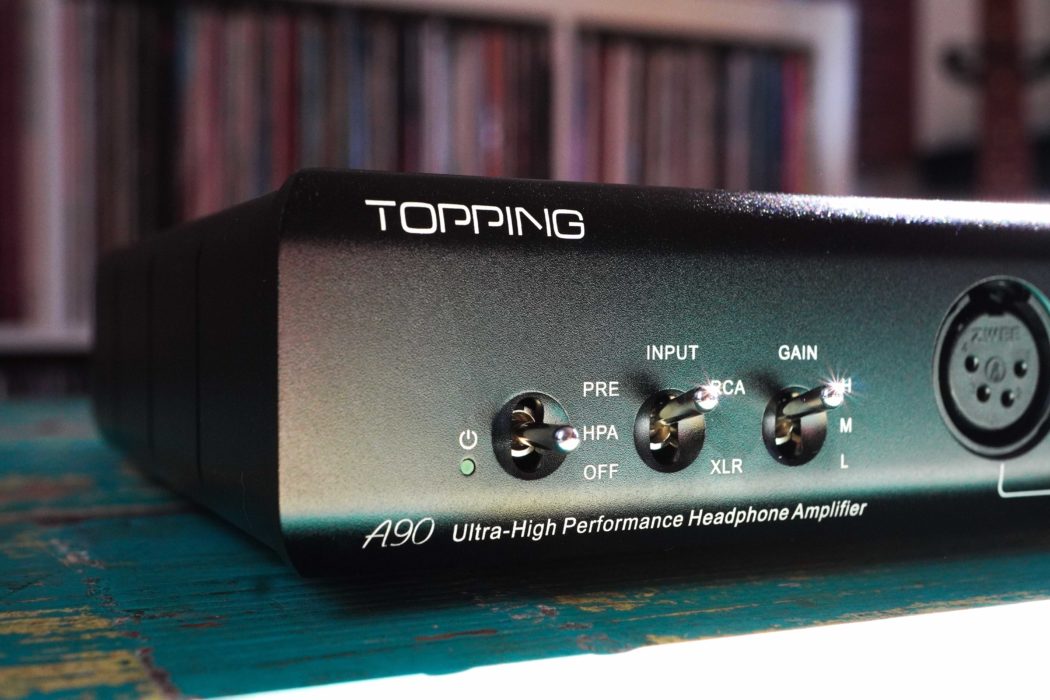
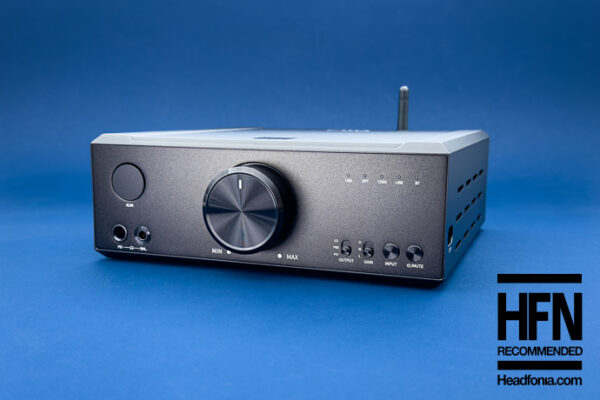
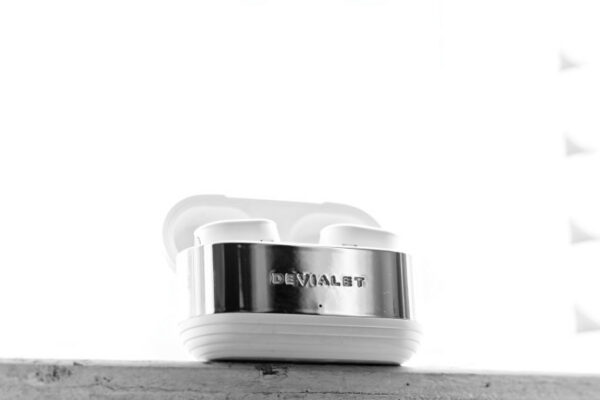
Lieven
last test comment
Clifford
I currently have a drop 789 and with my high end dac and hd800s have reached the best sound I have ever heard.
That said I’ve read that the 789 will compress the music and the A70 would be a far better choice. I’m setting up sereral systems around the house with a less expensive DAC. So getting another amp is in the planning.
Would I be improving my main system by replacing the AAA 789 with the A90?
I have asked the drop boards this and mostly got back less than useful information from people who have clearly not compared the two.
If the sound would not be much different using HD 800s headphones, I could save one or two hundred dollars on the computer setup. Not a lot but it would be a proven divise. If it will notably improve the sound, or slightly above notably improved, it would be worth the upgrade.
Thanks in advance.
Matty
You probably won’t hear a substantial difference. The A90 has the benefit of a fully balanced topology, plus balanced preamp facilities and 4.4mm output though.
Carl A
Hi,
Really good review, many thanks.
Some great comparisons with different headphones.
Can I ask what those aftermarket pads are that you are using with your Sine dx?
Be well.
Matty Graham
Thanks mate. They’re from Geekria: https://www.amazon.com/Audio-Technica-ATH-M50X-ATH-M20X-ATH-M30X-Headphones/dp/B07518L298/ref=cm_cr_arp_d_product_top?ie=UTF8&tag=headfi-20&ref_=d6k_applink_bb_marketplace
Danh
How do you feel about the Topping D90/A90 versus Burson Conductor 3x??? I know that 3x has the double price of D90/A90 combo, but can the Topping combo nearly reach the level of Burson? Thank you very much.
Matty Graham
Tough call without comparing them back-to-back. I loved the single-ended Conductor 3, ultimately it would come down to your budget and sense of aesthetics/form-factor preference. The 3X is hard to beat as an all-in-one unit.
Danh
Thank you very much. I have a chance to take the used 3x as the same price of new D90/A90 combo, for that reason I really want to compare both of them. The 3x receives lots of good reviews from many audiophiles. However, D90/A90 reach the highest measurement from Audio Science Review community. That’s make me wonder should I swap for the D90/A90 combo. For my main gear, I use JBL 305P powered speaker (3x acts at a DAC/Preamp), and HD660S.
Tony
ultra high performance for $499? Come on, be serious 🙂
Matty Graham
I would genuinely caution anyone arriving new to the hobby that price = performance (unless that’s a sarcastic emoji?). It’s a good time to be a consumer in this hobby right now with budget gear performing as strongly as this does.
Ben
Matty, I am curious as you have reviewed both the FA-10 and A90 what your feelings between the 2 are?
Matty Graham
Hi Ben, I personally haven’t listened to the FA-10 so I can’t give you a direct comparison. Linus reviewed it favourably, so it’s definitely also a very good amplifier. It’s a bit larger and a bit more expensive, so if a stepped attenuator and even more power (16 watts @ 32-ohms) are are important for you then it might be worth considering.
SAAD
I have both A90 and FA-10 while using D90 as my DAC. I love A90 over the FA-10. The A90 is transparent, powerful (can drive my Susvara easily) and extremely enjoyable to listen to. FA-10 is a colored sound, not as transparent, Mid-bass is boosted and midrange is made to sound meatier but not acurate. You can tell if you listen to the songs that you have listen for long period of time and also listen to the recorded voices of your friends and family. The treble has more detail on A90 with crisper leading and trail edges where FA-10 has smoother treble. I prefer A90 over the FA-10 for my headphone listening experience. It is not easy to beat A90.
Tibor
Hi. Guys, this is really the big question is Flux Lab FA-10 or 12 better? Timbre, slam, details. People are raving about it, high end for mid – fi price and we need answers!
Somebody help please! 🙂
Mel
Nice review and glad too see this site still running strong returning to after so many years👌
Question tough;
I am looking for a step up from my old jds element for my LCD2 (pre faz). And I’m going back/forth between the a90 and LP HPA RS02/08. Which one would u recommend?
Matty Graham
Thanks for reading Mel!
I’ve not had the chance to hear the Lake People set-up so I couldn’t give you a good comparison. I can say with confidence that the A90 will give you ample power and performance with the LCD2, and likely for anything else that you decide to pick-up down the track. What are you using as your source?
Mel
Hi Matty thank u for the reply!!! The only source I have now is my labtop and the element😁, but Im definitly be going to get a dac. Thinking about the d90 offcourse, but im open for suggestions.
Edu
Hi! I have a Chord Mojo a AKG K701 and a Sennheiser HD660S.
The A90 pairs well with the Mojo?And with the K701 and HD660S?
Thanks for your review;)
Matty
Hi Edu, if you’re looking to add a little more power to your set-up the Mojo ought to work perfectly as a DAC upstream of the the A90 when set to line-out mode. It has more than enough power for both the K701 and the HD660s and ought to provide a completely neutral signature to both.
taka
Hi- how does this A90 compare to Sabaj D5 or SMSL ?
Matty Graham
I haven’t listened to the Sabaj, but the Topping is more of a ‘purist’ analogue device and is also more powerful. Do you have a particular ‘SMSL’ in mind?
GR
I notice not many reviewers focus on “chip” vs discrete amps. The A90 sounds great as an op-amp example (which I think is it’s topology). Do you feel it suffers from dry and 2-D “chip” sound? And spending $1000+ on a decent entry/mid level fully discrete topology with decent transistors would add reality, depth, and tone, and be worth consideration?
GR
(and, ito of sound, not features, do you feel it differs much from the THX789? I find that tech to be impressive, netural, transparent, great detail, but still “flat” and “dry” compared to well-implemented discrete or tubes, and also a little fatiguing for long listening in the treble energy. I’ve heard some reviewers say the A90 is like the THX but a little more “musical” or “organic” – would you agree?)
ALex
Hi Matty,
Thanks for a great review. Do you know if there would be big difference between A90 + D90 vs Topping DX7 Pro ?
Thanks in advance